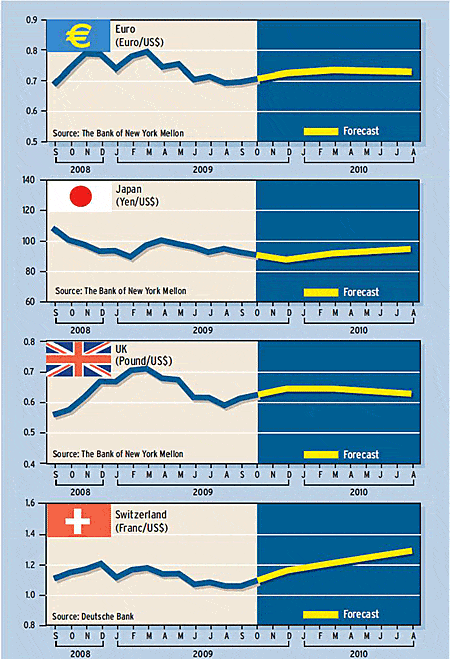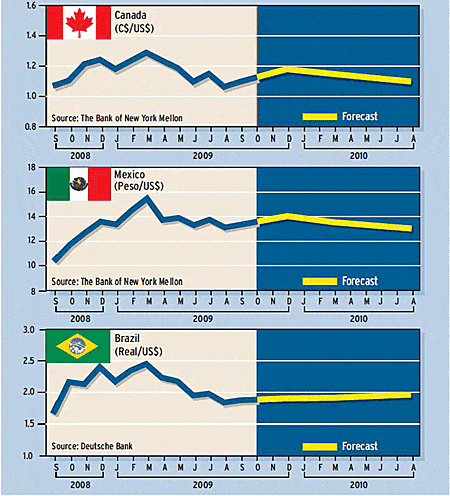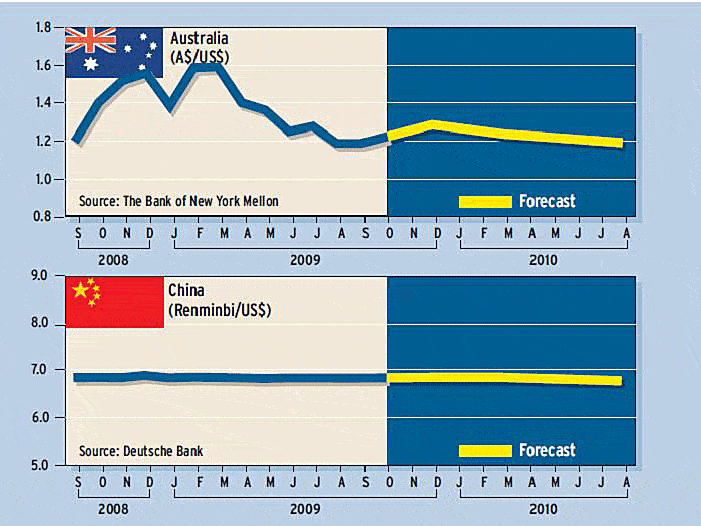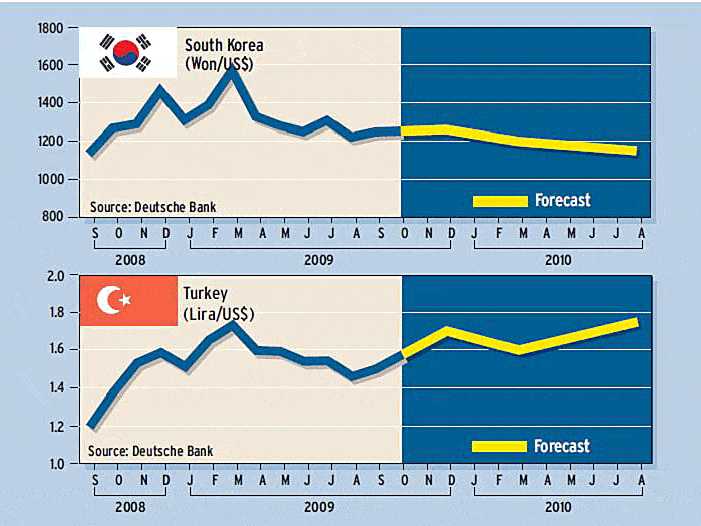Foreign Exchange
By Gordon Platt
As the global economic recovery gathers pace, the dollar is being undermined by the improvement in investors’ risk appetite. As US and other global investors seek higher returns in emerging markets and commodities, including oil, the greenback will continue to weaken, analysts say. The dollar has moved inversely to improving equity markets since March.
While questions remain about the sustainability of the US and global economic rebounds, portfolio flows are counteracting any benefit the dollar might receive from the narrowing US trade and current account deficits, analysts say.
“Ever since asset market confidence began to improve, the US private sector has bought foreign assets in size,” says Steven Englander, New York-based head of US foreign exchange research at Barclays Capital. “This swing in buying has offset the improvement in the US trade numbers by a large margin,” he says.
While some investors expected the dollar to rally as a result of the sharp drop in the US trade deficit, they may have been overly optimistic, according to Englander. Bigger swings in US funding requirements have come from US investor repatriation in 2008 and the more recent re-exporting of capital abroad, he says.
The growing US need for foreign funding paints a negative outlook for the dollar, Englander says. “There is no asset class in which US assets have a clear performance advantage,” he says. “Even without the uncertainty surrounding the policy framework, deficits and treasury issuance, there is a fundamental problem that US assets may not be that attractive compared with assets available elsewhere.”
With US private investors buying abroad, and foreign private investors selling dollar-denominated assets, foreign central banks are reluctantly filling the gap by buying US assets, Englander says.
As the global economy recovers, currencies linked to growth will likely be the best performers, says Michael Malpede, chief market analyst with Easy-Forex US, a Chicago-based online foreign exchange trading firm. Traders are trying to determine whether the US economic recovery will support the dollar, or whether the dollar will be pressured by improvement in risk appetite, Malpede says. Any doubts about the sustainability of the recovery will tend to support the dollar, he adds.
Currency Forecasts


If the global economic recovery is for real, demand for commodities will rise, and improved risk appetite will channel funds toward higher yields in emerging markets and away from the fiscal problems of the United States, analysts say.Meanwhile, currency traders are keeping an eye on the equity markets and could take any pullback in global stock markets as a signal to buy dollars as a safe haven in the storm.
The economic and financial crisis continues to command the attention of policymakers around the world, says Marc Chandler, global head of currency strategy at Brown Brothers Harriman, based in New York. “The monetary and fiscal footings are on emergency settings,” he says. “Sometime in that not-too-distant future, emergency settings will no longer be deemed necessary,” he adds.
Evidence is accumulating that the worst of the crisis is past, Chandler says. “If global fiscal and monetary stimulus prevented a more serious economic downturn, what happens if everyone begins removing the punch bowl at the same time?” he asks. It could be that coordinated rate increases will be required, whereas rate cuts over the past two years were staggered among the world’s central banks.
“There will be regulatory adjustments [as a result of the financial crisis] and maybe some coordination and even cooperation,” Chandler says. “But the failure to take advantage of the crisis to put economies on a more balanced footing will have far-reaching consequences that will likely reinforce powerful trends.” For example, if the US economy does enjoy an earlier and stronger recovery than in Europe and Japan, the growth differentials alone would likely widen the US current-account deficit again, he says.
As momentous as the crisis was, it was not sufficient to dissuade countries around the world from relying so extensively on the US consumer to buy their exports, Chandler says. In the modern global economy, with extremely volatile capital flows, countries have learned their lesson from past crises that they need to hold more reserves than traditional analysis suggests, he notes. Reserve accumulation appears to be already resuming after these holdings were drawn down during the worst of the crisis, as countries from Russia to South Korea intervened in the foreign exchange market. “The rebuilding and expanding of the reserve war chest may, in turn, be recycled and help finance the budget deficits of the industrialized countries,” Chandler says. The more things change, the more they stay the same, he says.
The dollar remains the world’s chief reserve asset, as well as its main invoicing currency and unit of account, due to many factors, Chandler says. “One of the factors is the size, depth and transparency of the US treasury [securities] market,” he says. “There is no other bond market that comes close to it. The European bond market is too fragmented. The Japanese bond market is too insular, and barriers to entry are great,” he says.
The treasury market and the dollar are also backed by the world’s strongest military might, Chandler says. US defense spending is nearly equal to the rest of the world combined, he adds. The US also invests more in improving its human capital and development, and the average education level in the United States is the highest in the world, Chandler says. “The idea that the US has lost its innovative edge and no longer produces goods is simply absurd,” he says. US productivity reached a record high in July 2009.
“It seems only prudent to be concerned about the record debt that the US is taking on,” Chandler says. Nonetheless, US government debt was a significantly smaller part of US gross domestic product than it was for most of Europe and Japan when the crisis hit, he says. Japan’s gross government debt is approaching 200% of GDP, and Japan’s problem has not been inflation, but its opposite, he says.
Meanwhile, the weaker dollar is not setting off alarm bells yet at the Treasury or the Federal Reserve. The dollar’s slide is helping to keep US exports competitive in global markets, which is helping to support the US recovery. Washington will come under pressure to repeat its desire for a strong dollar, however, if central bankers with large dollar reserves become panicky about the declining value of their investments.
Currency Forecasts





